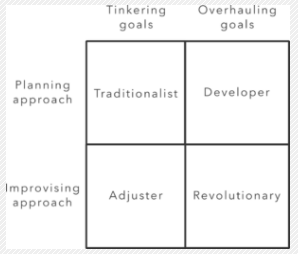Change that Never Goes Out of Style
There are a lot of great ideas. It is the leaders who can mobilize people to take action on ideas that are able to create change. Much like there are communication styles and management styles, we have different approaches to leading change. Outlined below are several steps you might consider in your strategy to lead your next idea from thought to reality.
Know your own approach to change. Are you a planner or an improviser? When you consider a change, do you think of each step that need to take place before reaching your goal? Do you consider the past is a direct indicator of future performance or that the answer can be found in the data? This is the planning approach. Or, assuming that the future is unpredictable, do you wait to see what will happen with the first step decision before you move on to make the next step? Do you assume that progress has ups and downs so move forward anyway? This is an improvising approach.
Know the goals of your change. Is the desired outcome of your idea to work around the edges of the defined problem by making small but necessary changes, or is your idea a to create major shift in the way of thinking or doing? Depending upon the problem to be solved solutions can be “tinkering goals” or solutions can have “overhauling goals”.
Know your change style*. By combining approach and goals, we can identify four types of change styles.
The Traditionalist makes small, well-planned changes.
The Adjuster leads change by increments, testing and observing to achieve change.
The Developer is a change manager with emphasis on predicting outcomes to achieve big changes.
The Revolutionary has big ideas and a rough idea on how to get there.
*Adapted from Get Them on Your Side, Dr. Samuel Bacharach, Platinum Press, 2005
Upon close examination we will find that resistance to change is actually not about the need for change. Rather, the resistance comes from the change style which might be perceived as too big, too small, too fast or too slow.
Know your stakeholder’s change style. Of all the people that might be impacted by your idea, where should you start? Make a list of your stakeholders—all of them. Thinking of their past initiatives and watching them in action—identify each person’s typical approach and the goals of the ideas that they have shared. Are they planners or improvisers; tinkerers or over-haulers?
Get started with the path of least resistance. Stakeholders with the same agenda have a good chance to be your earliest adopters. Those in an opposite quadrant are the most likely to be the most resistant. Those who share goals, but have different approaches are you next most likely allies, and those who share a similar approach but have different goals are potential resistors. Don’t ignore alternative styles. Like all good leaders also pay attention to your resistors.
Lead. You do not have to wait until everyone is on-board. Now that you have adopters– followers–you are the leader. These early adopters are not enough. You must continue to solidify and grow your coalition, by showing successes, moving forward by working out differences. Make things happen until a tipping point is reached in which your idea becomes the new norm.
Rather than building a group of followers around your great ideas, try the approach of building a group of followers around your style of leading change.











